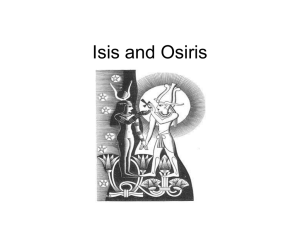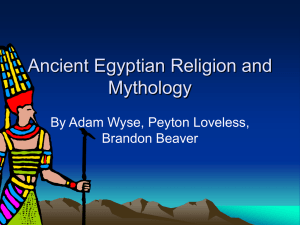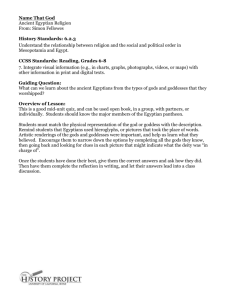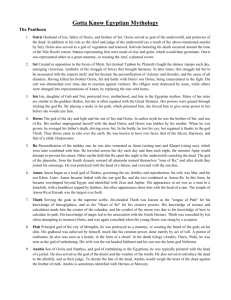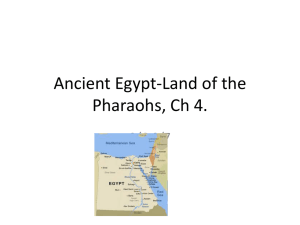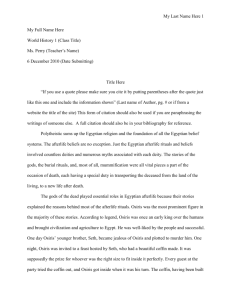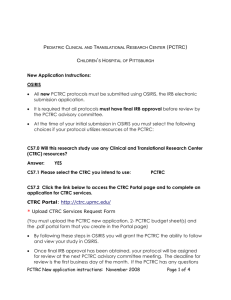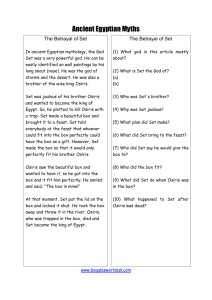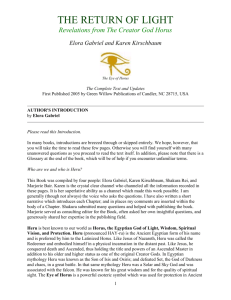Women in Ancient Egypt
advertisement
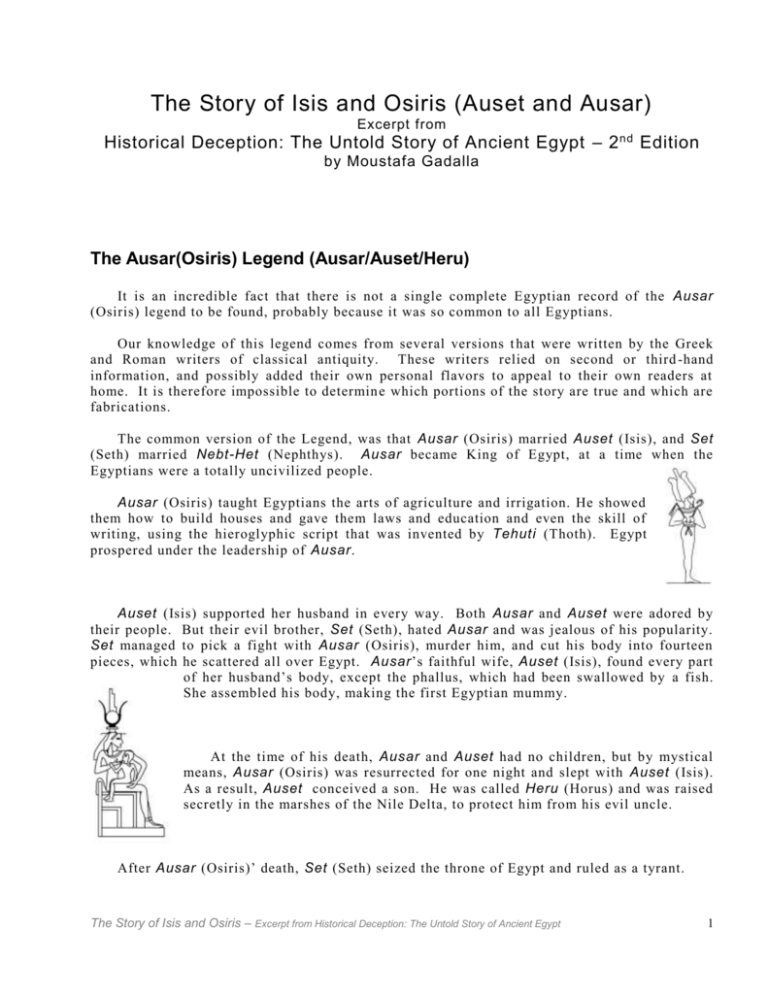
The Story of Isis and Osiris (Auset and Ausar) Excerpt from Historical Deception: The Untold Story of Ancient Egypt – 2 nd Edition by Moustafa Gadalla The Ausar(Osiris) Legend (Ausar/Auset/Heru) It is an incredible fact that there is not a single complete Egyptian record of the Ausar (Osiris) legend to be found, probably because it was so common to all Egyptians. Our knowledge of this legend comes from several versions t hat were written by the Greek and Roman writers of classical antiquity. These writers relied on second or third -hand information, and possibly added their own personal flavors to appeal to their own readers at home. It is therefore impossible to determin e which portions of the story are true and which are fabrications. The common version of the Legend, was that Ausar (Osiris) married Auset (Isis), and Set (Seth) married Nebt-Het (Nephthys). Ausar became King of Egypt, at a time when the Egyptians were a totally uncivilized people. Ausar (Osiris) taught Egyptians the arts of agriculture and irrigation. He showed them how to build houses and gave them laws and education and even the skill of writing, using the hieroglyphic script that was invented by Tehuti (Thoth). Egypt prospered under the leadership of Ausar. Auset (Isis) supported her husband in every way. Both Ausar and Auset were adored by their people. But their evil brother, Set (Seth), hated Ausar and was jealous of his popularity. Set managed to pick a fight with Ausar (Osiris), murder him, and cut his body into fourteen pieces, which he scattered all over Egypt. Ausar’s faithful wife, Auset (Isis), found every part of her husband’s body, except the phallus, which had been swallowed by a fish. She assembled his body, making the first Egyptian mummy. At the time of his death, Ausar and Auset had no children, but by mystical means, Ausar (Osiris) was resurrected for one night and slept with Auset (Isis). As a result, Auset conceived a son. He was called Heru (Horus) and was raised secretly in the marshes of the Nile Delta, to protect him from his evil uncle. After Ausar (Osiris)’ death, Set (Seth) seized the throne of Egypt and ruled as a tyrant. The Story of Isis and Osiris – Excerpt from Historical Deception: The Untold Story of Ancient Egypt 1 As soon as Heru (Horus) had grown to manhood, he challenged his evil uncle, Set, for the right to the throne. After many battles and challenges, Heru eventually overcame Set, avenged the murder of his father, and regained the throne of Egypt. Heru became a role model, the type of pe rfect Pharaoh. Subsequently, all other rulers used the name Heru as one of their official titles, throughout the Egyptian history. The Pharaohs identified themselves with Heru as a living king and with the soul of Ausar (Osiris) as a dead king. During the battle, Set snatched away the eye of Heru, and threw it into the celestial ocean. Tehuti (Thoth) recovered the eye that was later called the Uatchet-Eye. It was identified with the moon and became a very popular symbol of protection. It was this ey e that Heru used to revive his sleeping father. Ausar (Osiris) was resurrected as a soul to rule the Netherworld. Ausar became the spirit of the past for the Egyptians, the neter of the Dead, and a hope for resurrection and afterlife. Another version of the story indicates that as soon as she heard of this tragedy, Auset (Isis) set out to search for the fragments of her husband’s body, embalmed them with the help of the neter, Anpu (Anubis), and buried them wherever they were found. According to this ve rsion of the story, the head of Ausar (Osiris) was buried at Abtu (Abydos). The heart was buried on the island of Philae, near Aswan. The phallus was thrown into the Nile and was swallowed by a fish. For this reason the eating of fish was forbidden to t he priests. Another tradition says that Anpu (Anubis) and Auset (Isis) assembled the embalmed fragments and buried them all at Abtu (Abydos). Divine Love Many are frightened by the relationship of Ausar and Auset as a married couple and also as brother and sister. Within a larger cosmology, this relationship can be seen as an instinctive form of devotion and love. It was, and still is, common in Egypt, for a husband/wife to call each other sister/brother as a sign of love and devot ion, and not because they are biologically brother and sister. (Also see the chapter, Love, Egyptian Style.) Any woman who truly loves her husband is considered to be like Auset, and has the power of awakening him into greater life, as Heru. Father S.J. Vann likened the awakening of Christ by Mary Magdalene, as he emerged from his tomb, to Auset awakening Ausar from the dead. The comparison between the two cases is illuminated in the “Lament for Ausar(Osiris)”, in which Auset and her sister Nebt-Het (Nephthys) bewailed their brother Ausar’s death, and pleaded with him to come back to life. The text for this duet was derived from a much older lamentation. The Story of Isis and Osiris – Excerpt from Historical Deception: The Untold Story of Ancient Egypt 2 “Lament for Ausar” was described by Andrew Lang to “have the power to stir our deepest emotions” : Sing we Ausar (Osiris) dead, Lament the fallen head: The light has left the world, the world is gray. Athwart the starry skies The web of darkness flies, And Auset weeps Ausar passed away. Your tears, ye stars, ye fires, ye rivers shed, Weep, children of the Nile, weep for your lord is dead! Softly we tread, our measured footsteps falling Within the sanctuary sevenfold; Soft on the dead that liveth are we calling: ‘Return, Ausar, from thy Kingdom cold! Return to them that worship thee of old. Within the court divine The sevenfold sacred shrine We pass, while echoes of the temple walls Repeat the long lament The sound of sorrow sent Far up within the imperishable halls, Where, each in other’s arms, the sisters weep, Auset and Nebt-Het o’er his unawakening sleep. Softly we tread, our measured footsteps falling Within the sanctuary sevenfold; Soft on the dead that liveth are we calling: ‘Return, Ausar, from thy kingdom cold! Return to them that worship thee of old.’ 0 dweller in the west, Lover and lordliest, Thy love, thy sister Auset, calls thee home! Come from thy chamber dun, Thou master of the sun, Thy Shadowy chamber far below the foam! With weary wings and spent Through all the firmament, Through all the horror-haunted ways of hell, I seek thee near and far, From star to wandering star, Free with the dead that in Amenti dwell. I search the height, the deep, the lands, the skies, Rise from the dead and live, our lord Ausar, rise! The Story of Isis and Osiris – Excerpt from Historical Deception: The Untold Story of Ancient Egypt 3
